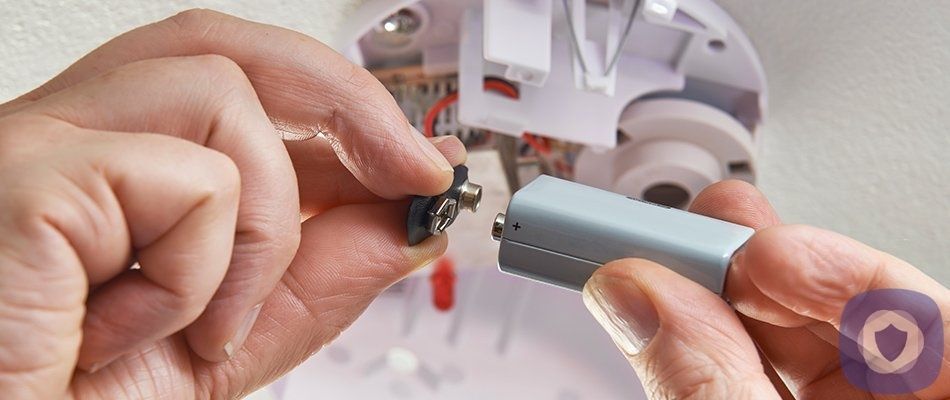When a smoke alarm keeps beeping, the usual culprit is a low battery, typically changing the batteries is all you need to do, whether it’s battery-powered or hardwired into a backup battery. Sometimes, though, this isn’t the problem, and you’ll put in a new battery only to find that the smoke alarm continues making the same sound. Since the risk of dying in a house fire is cut in half when you have a working alarm system, it’s a crucial part of your home safety.
What causes beeping?
The “beep” or “chirp” is usually your smoke detector trying to communicate that there is an issue. Today we’ll be looking at the most common reasons your alarm may be beeping and how to solve the related problems.
Battery Issues
We’ve already covered changing the battery, but there are several other issues that you need to consider.
- Battery terminal obstructed: When replacing a battery, you should ensure nothing blocks the connection. Corrosion, dust, ash, or pollen can prevent proper functioning. If you have corrosion, you should carefully check whether you need a new unit. After removing the battery for replacement, you should carefully vacuum the inside to remove any debris before putting the new battery in.
- Battery drawer opens: When replacing the battery, you should ensure that the new battery fits precisely in the slot and that the drawer closes completely. Not all models have drawers, but if present, they must close properly. If the drawer is not fully closed, the battery may not power the terminal correctly. You should also ensure that the unit’s lid is closed and that it is securely mounted.
- Battery pull-tabs: Probably the most straightforward issue on this list, if you’ve recently changed the batteries in your alarm, you may have neglected a minor issue. On some units, a small security peg must be pulled out to open the drawer and remove the battery; this peg must be pushed back once the battery is changed.
If you recently installed a hardwired model with a 10-year sealed backup battery, chirping may indicate that you did not remove the battery pull tab. This tab must be removed for the alarm to function correctly.
Temperature fluctuations
Another common reason for an alarm to beep or chirp erratically is temperature variations; if you’ve set the thermostat at a very high or low temperature, the smoke alarm may issue sounding alerts. Another reason it could chirp is if it detects hot, humid air coming from the kitchen or bathroom. This can happen if you’ve just taken a hot shower or cooked a meal; in order to avoid this kind of false alarm, it’s best to move the smoke alarms to an area with a more stable temperature.
Interrupted light beam
You should consult your manufacturer’s instructions for this step, but your smoke detector may need a clean. The small light sensor housed in some models of smoke detectors can be susceptible, so a bit of dirt, ash, or pollen can interrupt the light beam and set off beeping. You can clean your smoke detector to avoid this, you can usually do this with a microfiber cloth, vacuum cleaner, or compressed air, but you’ll want to consult the manufacturer for advice on this step.
Investigate your other detectors
If you have several smoke detectors in your home, you could be misinterpreting your detectors’ sounds. For example, you could be checking the sensor in your hallway only to find out it was the detector in your kitchen making the sound all along. Imagine fussing with a detector only to discover the issue was with a different one… it happens. So do be sure to check all of your smoke detectors.
Investigate your other devices
In the same vein, you should check that your other alarms, for example, carbon monoxide alarms or a part of your home security system, may need your attention. As with the above, you could spend hours working on your fire alarm only to find out that it was your carbon monoxide detector sounding off the whole time.
A replacement is required.
The recommended lifespan for a smoke detector is around ten years, as per the national fire protection associations’ recommendations; you should check the date on the back of your smoke detector. If it is 8-10 years old or older, you should arrange a replacement rather than attempting further troubleshooting.
Error build-up
Some of the more modern fire alarms on the market are smart alarms that adapt to their environment and record errors. Over a prolonged period, these errors can build up and eventually trigger the alarm. The way to fix this is by resetting your alarm, which can be done differently.
How to reset your smoke alarm
If you have an error build-up or have tried one of the above remedies and the smoke alarm continues to beep, then it’s possible that it now needs a reset. Either way, it can’t hurt to try. The method is slightly different for hardwired smoke detectors vs. battery-operated smoke detectors. There is also using the reset button.
Reset Button
This should be your first attempt to stop your smoke detector from beeping, and intermittent chirping can often be stopped by performing a simple reset. You can do this by holding the reset button for up to 30 seconds. If this doesn’t work, continue to one of the more comprehensive reset methods.
Hardwired Alarms
- Go to your electrical panel, look for a circuit breaker labeled “central alarm” or “smoke detector.” Toggle the breaker into the off position.
- Take the smoke detector off its mounting bracket (from the ceiling) and disconnect the power cable.
- Take out the battery, press the “test” button, hold it down for at least 10 seconds. An alarm may sound for a short time, but it’ll quickly silence.
- Install the battery in the smoke detector, reconnect the power cable and mount the smoke detector again. Turn the breaker back on. The smoke alarm will chirp to indicate power was restored to the unit.
Battery Powered Alarms
- Remove the battery from the battery compartment.
- Press the “Test” button holding it down for 15 seconds. You should expect an alarm to sound for a short time, and then it will silence.
- Install the battery back in the smoke detector. The smoke alarm will chirp once to indicate the battery is connected.
The Final Word
Smoke alarms are a crucial part of home safety, and you should always ensure that they’re in good working order. Three out of five fire deaths happen in homes with no working smoke detectors.
It’s easy to change your smoke detectors’ batteries and troubleshoot most issues; however, if you suspect your alarm isn’t working as it should be or you can’t get the irritating alarm sounds to stop, then you should consider enlisting the help of an alarm technician or an electrician.
This article has been reviewed and approved by Officer Banta.

Officer Banta is the official SecurityNerd home security and safety expert. A member of the Biloxi Police Department for over 24 years, Officer Banta reviews all articles before lending his stamp of approval. Click here for more information on Officer Banta and the rest of our team.

